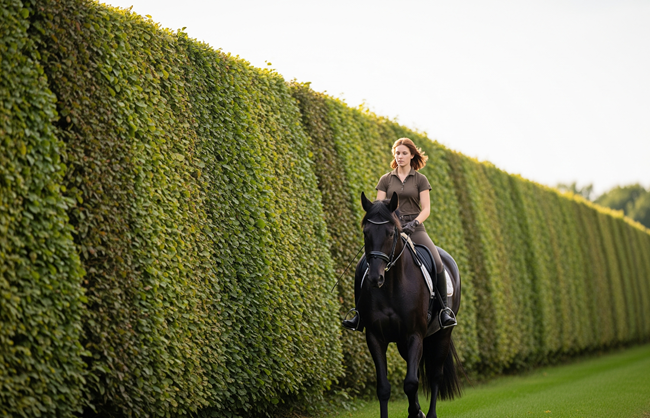
It is not uncommon for a horse to become skeptical of elevated items close to them as most feel that they are vulnerable to attack from the side and at a distance from objects higher than they are, therefore, they will try to avoid the objects to protect themselves. This action is not about the objects or people along the rail, it is about confidence and their need for security. Conditioning exercises begin away from the arena where the horse can be sensitized to objects on both their left and right side and at varying heights.
As the horse develops confidence by sensitizing and desensitizing them, we can begin working with the horse to address their inherent feeling of claustrophobia, a feeling that is normally recognized on one side of the horse than on the other side. To begin developing their confidence and to negate this feeling of claustrophobia on their four sides, find a position 3-4 feet from a fixed object such as a fence line or rail in which the horse will proceed between you and the fixed object. Drive the horse with the tail of the lead rope to have them squeeze between you and the fixed object. If they will not squeeze between you and the object take a step backwards and open the distance by about one foot and attempt again. Keep repeating these steps until the horse feels comfortable enough to pass thru between you and the object. You will notice that the distances will vary on each side of the horse, as will the speed they are willing to move between them. Repeat these steps while closing the gap in small increments. If the horse shows some resistance back off half the distance and try again. When the horse passes thru reward their attempts.
This process will help them build confidence by reducing their feelings of claustrophobia. Make your movements consistent and repeat and proceed on the premise of “Approach, Retreat, Relax and Reward”. These become the rules of four when dealing to overcome a lack of confidence and to negate hypersensitivity to the sides of a horse. After the horse begins to develop more confidence, you can increase varying the objects on the sides of the rails and at different heights. After this you can begin dealing with lack of confidence and concern issues for the horse such as judges and reviewing stands. Bring your horse into the arena and begin a series of exercises that require your horse place their attention on you. This can be accomplished by ground movements of directing their forequarters in and out, their hind quarter movements. Use no more than three or four movements to the left and the right always beginning in the direction of the horses strong side.
Once you have obtained your horses’ attention, mount up and mirror image the exercises to garner your horses’ attention while being ridden. Dismount and work your exercises now on the ground in the general vicinity of the reviewing stand/judges stand, allowing the horse to approach, retreat, relax and then reward when they take the smallest of steps in the direction of the stand. Once the horse is comfortable remount and begin to repeat the exercise once again using the approach, retreat, relax and reward theory. Now begin to ride the horse in a straight line passed the sensory object at a distance that they feel comfortable the same as when you were performing the exercises between you and the rail. If your horse refuses, immediately stop and turn the horse ninety degrees away from the object and take a few paces and turn ninety degrees again and ask the horse to advance. By taking these ninety-degree maneuvers you are empowering your horse to deal with the event and are splitting the difference with your horse. The horse is not going in the direction you wanted, and you are not going in the direction they want to go. Keep performing this strategy and you are now back in the direction you originally intended to go.
Make a mental note on how far you got on the last request and see if you can get just a step closer and if you are successful immediately stop and reward the horse. Keep repeating this exercise using small increments and always stopping to reward the horse as you progress. If you are not progressing, go back and split the difference with the horse using the ninety-degree strategy and before long you will be getting your horse to go closer to the fixed objects than they had previously. Remember, never force the horse when they encounter scary objects, places or things as the horse will go immediately to survival mode and their reaction will be to flee from fear. Take small steps and your rewards will be large leaps in your success in overcoming the horse’s fear.
Provided by Dan Kuhn Natural Horse-Man Services
Crazy Horse Laws
A misworded ordinance in Wolf Point, Montana: “No horse shall be allowed in public without its owner wearing a halter.”
West Union, Ohio: “No male person shall make remarks to or concerning, or cough, or whistle at, or do any other act to attract the attention of any woman riding a horse.”
A 1907 Cumberland County, Tennessee statute reads: “Speed while on horseback upon county roads will be limited to three miles an hour unless the rider sees a bailiff who does not appear to have had a drink in thirty days, then the horseman will be permitted to make what he can.”


Comment here